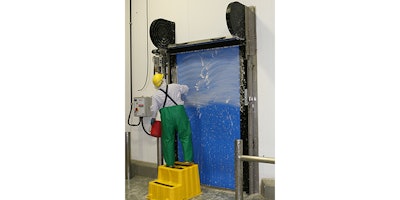
The combination of technological advancements, increased regulation and efficiency initiatives have transformed many industries, perhaps none more than food manufacturing. A prime example of this can be seen in the design and composition of doors and walls for cleanroom and wash-down applications.
Product integrity and contamination control are ever-present concerns in any food processing facility, and clean rooms and wash-down protocols play a key role in ensuring both. Removing contaminants from production processes also prevents premature spoilage and enhances product longevity.
While clean rooms in different industries aren’t exactly the same, they are designed with the same goals in mind — to remove particles, fibers, chemicals and bacteria. These environments have a controlled level of contamination specified by the number of particles per cubic meter at a specified particle size.
The Role of High-Speed Doors
High-speed doors and fabric curtain walls play an essential role in maintaining clean operations and food product integrity. Designed to address food facility needs for environmental control, productivity and safety — as well as cleanliness — they are used not only to prevent cross-contamination, but also to help air circulation rates and optimal operating efficiency.
The U.S. Food and Drug Administration (FDA) cleanroom standards outline recommendations and requirements for manufacturers. The starting point is to look for doors compliant with Current Good Manufacturing Practices (cGMP), the FDA and the United States Department of Agriculture (USDA). While these agencies do not specify clean room regulations in the food industry, they do provide guidelines based on Hazard Analysis & Critical Control Points (HACCP) best practices. As such, designers should seek out products that specifically cite their compatibility with these protocols.
Key considerations for any door configuration are ease of cleaning and durability. Especially in food operation cases, doors must be able to stand up to repeated cleaning with chemical solvents, and have a smooth, hard and non-porous surface resistant to microbial and fungal growth. Doors should also have a tapered surface and edges that essentially eliminate harborage of dust or other contaminants, and possess no sharp angles to minimize harborage of microbes. Additionally, they should be corrosion-resistant (which is often a problem with older door systems) and use stainless steel side frames and shrouds.
It is also advisable to avoid doors with exposed fasteners and coils, as they will take longer to clean and could harbor contaminants.
 Photo courtesy of Rite-Hite
Photo courtesy of Rite-HiteThe New Generation of Cleanroom Doors
Traditionally, food manufacturing facilities used bi-parting doors made from stainless steel or fiberglass. However, many facilities are moving toward upward-acting “roll-up” doors due to limited wall space in a plant. A rigid-panel center-opening door spanning a six-foot-wide opening, for example, requires approximately three feet of wall space on each side when its panels open. A roll-up door, on the other hand, requires none, since its fabric “curtain” collects in a head assembly at the top of the door when it is opened.
A new generation of roll-up doors — featuring anti-microbial materials and other clean room upgrades — has come on the market in recent years. These new features, coupled with their tight sealing and ability to operate at high cycle speeds, are reasons they are catching on with food manufacturers. State-of-the-art high-speed door models can move at up to 100-inches per second, minimizing air intrusion while also decreasing the likelihood of forklift collisions. If they are bumped or impacted, their curtain automatically snaps back onto the door track.
Made from smooth 100 mL Duramax (which is highly resistant to acids and bases and has a low water absorption rate), industry-leading doors are highly resistant to mold and have superior wash-down qualities. They use a one-piece radial header (with easy draining during cleaning) and non-corrosive Lexan and UHMW side frames which stand off from the wall to minimize surface-to-surface contact, reducing pockets where bacteria can grow.
To ensure complete 360-degree clean capability, the side frames can be removed for cleaning and the drive system and controls are completely sealed and wash-down rated, meeting both USDA and FDA standards.
Wash-Down Walls
Fabric walls and industrial curtain partitions also play key roles in maintaining sanitary conditions in food manufacturing facilities, where they are increasingly being used for applications related to blending, mixing, powder ingredients, raw ingredients or other production operations. While anti-microbial walls have always been important in segmenting environments, there is a growing use of flexible, industrial fabric walls around processes where wash-down protocols apply. Not only are they quicker, easier and less expensive to install than walls made of traditional materials, they can be moved or reconfigured if the facility’s needs or floorplan changes.
One of the most common uses for industrial fabric walls in the food industry is for the isolation of production lines so they can be cleaned while other lines nearby continue to run at peak efficiency. Not only do these flexible fabric walls allow plant engineers to easily enclose areas and contain overspray from cleaning, but they can also help reduce potential for cross-contamination during production processes.
Some wash-down fabric walls are constructed of durable, cleanable and anti-microbial vinyl specifically designed for use in operations where compliance with federal food regulations is paramount. To eliminate the potential for harborage concerns, fabric walls with manufactured panels with heat- or radio-frequency-welded seams, and air- and water-tight panel-to-panel connections, should be employed.
Wash-down fabric walls are typically suspended from existing ceiling structures or roof decks. Stainless steel components and hardware allow the walls to hold up to wet and harsh conditions that occur when production equipment is cleaned as part of HACCP best practices protocol. Should the ability to open and close the wall be needed, heavy-duty stainless steel track-and-trolley systems are available to ensure easy operation and durability in the wash-down environment.
Flexibility and potential cost savings are among the main benefits of fabric walls in any application. Since they are not rigid, they can easily be custom-designed to match a facility’s specific needs or work space, and can be moved or reconfigured if those needs change. When combined with anti-microbial, wash-down features, this flexibility allows plant managers to achieve cleanliness protocols and production goals without the cost, permanence or space requirements of rigid walls.
Conclusion
To ensure product integrity, food manufacturing facilities require the most sanitary operations and equipment possible. From high-speed roll-up doors to anti-microbial, wash-down fabric walls, new products are changing the way the industry defines “best practices” in both areas.





















